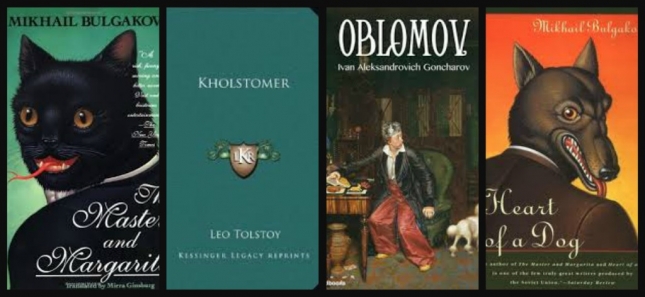It's amazing who you meet when you read more broadly.

If you have tired of watching Anna Karenina’s anguished life on film, seeing Raskolnikov’s next villainous act recreated in the comics, or enduring one too many Lolita wannabes in print or on the screen, it’s time to dig deeper into Russia’s literary troves. There, you’ll find rogues, critters, ghouls, and body parts — in other words, some of the most fascinating fictional characters you could ever hope to meet.
Benya Krik from The Tales of Odessa by Isaac Babel. Paraphrasing the author, Benya Krik is an Isaac Babel original, unlike any traditional Russian Jewish shtetl dweller “with spectacles on his nose and autumn in his heart.” King of the gangsters in Odessa’s Jewish ghetto Moldavanka, Krik is a “lion,” a “tiger,” a “cat.” His very tread in squeaky fine leather boots makes the heart flutter. Just wait until you read of his exploits.
Voland and Begemot from The Master and Margarita by Mikhail Bulgakov. Babel’s contemporary Mikhail Bulgakov embeds fantasy and sorcery in satire. His best-known work, The Master and Margarita, boasts a cast of characters boundlessly fascinating and marvelously qualified, including Yeshua (Jesus) and Pontius Pilate. But our focus is on two others — the Devil, Voland, and his traditional accomplice, a talking black cat named Begemot (or Behemoth). They prowl the city playing supernatural tricks on Moscow’s hypocritical denizens.
The mongrel from Heart of a Dog by Mikhail Bulgakov. If you’re a dog rather than a cat person, you may want to set aside The Master and Margarita and instead pick up Bulgakov’s Heart of a Dog, a searing account (sometimes compared to Orwell’s Animal Farm) of a mongrel’s life following a human organ transplant.
Oblomov from Oblomov by Ivan Goncharov. Going back to the 19th-century golden age of Russian prose is this satire of a slightly different cut. The title role belongs to a human slug named Oblomov, created from the pen of the much under-valued (at least abroad) genius Ivan Goncharov. Oblomov may be the only literary character who never gets out of bed, as a recent film put it. In a way, Oblomov is most akin to the character Lolita, surpassing literature and equated with a whole segment of human conduct or misconduct.
Kholstomer from Kholstomer (a.k.a. Strider) by Leo Tolstoy. From the pen of Tolstoy, a horse comes alive long before the War Horse craze. In his own words, the racehorse Kholstomer — whose name is commonly translated as Strider — gives a weepy account of his honest past, contrasting it sharply with his master’s corrupt and dishonest ways. Kholstomer is also remarkable for another reason. After writing about his “noble horse,” Tolstoy parted ways with meat once and for all.
The Nose from “The Nose” by Nikolai Gogol. More grotesque than fellow scribes’ above, the Kafkaesque Gogol’s characters may be the most fascinating of all. Not only do his creations include foul beings and monsters, they also include body parts. The Nose, from the short story by the same name, parades about St. Petersburg in military uniform, alive and well, independent and self-assured, a character who lately found his way onto the Metropolitan Opera stage.
Viy from “Viy” by Nikolai Gogol. In this chilling short story, the demon Viy comes to life after being invoked by a pretty young witch hoping to avenge her own murder. An evil spirit with a repertoire that can turn a corpse upside down (literally), Viy is a frightening character, and this is a frightening tale. Akin to an Edgar Allan Poe story, it is only a suitable bedtime read for those unafraid of the dark.

